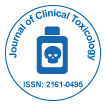
Journal of Clinical Toxicology
Open Access
ISSN: 2161-0495

ISSN: 2161-0495
Perspective - (2025)Volume 15, Issue 2
Poisonous effects, or toxic effects, are the harmful consequences resulting from exposure to chemical, biological, or physical agents. These substances, known as toxicants or poisons, can originate from natural sources such as plants, animals, and minerals, or be synthetic, including industrial chemicals, pesticides, and pharmaceuticals. The study of their effects is essential in toxicology, medicine, pharmacology, and public health. As modern life becomes increasingly dependent on chemicals, the potential for accidental or deliberate exposure to poisons has grown, warranting urgent attention and intervention.
Poisonous effects are determined by several factors including the dose, duration of exposure, route of entry (ingestion, inhalation, dermal contact), and the individualâs genetic and physiological makeup. A fundamental concept in toxicology is âthe dose makes the poison.â Even substances considered harmless, like water or vitamins, can become toxic in excessive quantities, while deadly poisons in minute doses may be therapeuticâas seen in drugs like digoxin or botulinum toxin. Additionally, the environment plays a key role in influencing exposure levels, particularly in areas with inadequate pollution control or improper waste management.
Acute poisoning refers to immediate or rapid onset of symptoms following a high dose exposure. Examples include carbon monoxide poisoning, snakebites, or accidental ingestion of household cleaners. Chronic poisoning, on the other hand, involves prolonged exposure to lower levels of a toxin, leading to gradual accumulation and long-term health problems. Lead exposure in children, for example, can impair cognitive development, while occupational exposure to asbestos is known to cause mesothelioma decades after initial contact.
Analysis, and imaging studies, play a vital role in identifying the causative agent and assessing the severity. Treatment of poisoning includes removing the individual from the source of exposure, administering antidotes if available, and providing supportive care to maintain vital functions. Activated charcoal, for instance, is commonly used in acute oral poisoning to absorb toxins in the gastrointestinal tract. In some cases, chelation therapy may be employed to bind and remove heavy metals like arsenic or lead. Prompt medical attention often determines the outcome in poisoning cases, highlighting the need for public access to emergency care.
Beyond individual care, prevention remains the most effective strategy in addressing poisonous effects. Public education on safe storage and usage of chemicals, clearer labeling of toxic substances, strict industrial safety regulations, and rapid-response poison control centers are crucial in minimizing risks. In agricultural and low-resource settings, where pesticide poisoning is a major concern, awareness programs and alternative pest control methods can significantly reduce exposure.
In conclusion, poisonous effects represent a complex interplay of exposure, vulnerability, and systemic preparedness. With the growing presence of toxic agents in our environment, a multidisciplinary and preventive approach is essential. Bridging science, policy, and public awareness can help protect individuals and communities from the silent but potentially devastating consequences of toxic exposure.
Citation: Zhang EJ (2025). Poisonous Effects on Human Physiology and Environment. J Clin Toxicol. 15:591.
Received: 03-Mar-2025, Manuscript No. JCT-25-37526; Editor assigned: 06-Mar-2025, Pre QC No. JCT-25-37526 (PQ); Reviewed: 20-Mar-2025, QC No. JCT-25-37526; Revised: 27-Mar-2025, Manuscript No. JCT-25-37526 (R); Published: 07-Apr-2025 , DOI: 10.35248/2475-3181.25.15.591
Copyright: © 2025 Zhang EJ. This is an open-access article distributed under the terms of the Creative Commons Attribution License, which permits unrestricted use, distribution, and reproduction in any medium, provided the original author and source are credited.